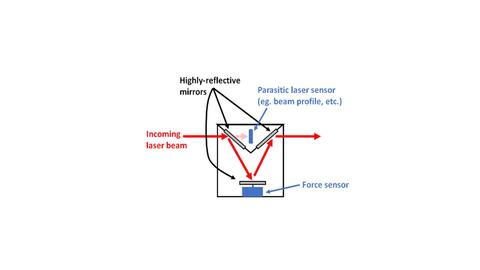Non-attenuating Meter for Determining Optical Energy of Laser Light
Patent Number: 10,837,828
Problem
Patent description
NIST has invented a device that permits full and accurate characterization of a laser beam without attenuating the laser beam or perturbing its direction. The unique three-mirror design allows the absolute power to be measured via radiation pressure (from the force on one mirror) while the negligibly-small fraction of light that leaks through the other two mirrors can be measured parasitically for a variety of laser beam parameters such as transverse profile, temporal response, spectral signature, etc. This unique design also redirects the laser beam to impinge on a horizontal mirror for force measurement, which allows the use of a variety force-sensor designs or "off-the-shelf" scale technologies.
Currently, for laser beams in the anticipated power range of this instrument, there is no means of measuring the beam profile in an absolute (fully-calibrated) sense without perturbing (absorbing or scattering) the beam. By coupling a radiation-pressure power measurement with a parasitic beam profile measurement, we enable the absolute power to be measured and then the relative beam profile result can be calibrated to the absolute power for an absolute beam profile measurement. This same approach can be taken for other relative measurements such as fast power response, spectral content, etc.
With this design that permits a vertically directed force measurement, it is compatible with a variety of force-sensing technologies. This can allow for a lower-cost force sensing solution. This also simplifies the calibration process and eliminates a contribution to the power meter’s uncertainty statement, permitting lower overall measurement uncertainties.

Invention
A non-attenuating meter determines optical energy of laser light in an absence of optical attenuation of the laser light and includes: a recipient mirror that: receives laser light that propagates in a primary propagation direction; produces profile light; transmits the profile light through the recipient mirror along the primary propagation direction; produces first reflected light from the laser light; and reflects the first reflected light along a secondary propagation direction; a profilometer in optical communication with the recipient mirror and that: receives the profile light from the recipient mirror along the primary propagation direction; and produces a profile signal from the profile light; a sensor mirror in optical communication with the recipient mirror and a passer mirror and that: receives the first reflected light from the recipient mirror along the secondary propagation direction; produces, in a tertiary direction, a sensor force from the first reflected light; communicates the sensor force to a force sensor along the tertiary direction; produces a second reflected light from the first reflected light; and reflects the second reflected light in a tertiary propagation direction; the passer mirror in optical communication with the sensor mirror and that: receives, along the tertiary propagation direction, the second reflected light from the sensor mirror; produces pass light from the second reflected light; and reflects the pass light along the primary propagation direction, such that the non-attenuating meter does not attenuate the optical energy of the laser light and does not change the primary propagation direction of the laser light.
Features
- Our design accepts a horizontally-directed laser beam and re-directs it to measure its force in a vertical direction and again redirects it to its original horizontal direction. This allows the use of a variety of commercial or custom-designed force-sensing technologies (scales) which were not previously usable for this application.
- No other technique has been demonstrated to simultaneously measure absolute laser power and a variety of other laser beam parameters (such as beam profile, spectral content, beam divergence, beam quality factor, fast temporal response) non-perturbatively. This design also permits such relative parameters (beam profile, temporal response, etc.) to be calibrated to the radiation-pressure-based laser power measurement for each laser injection.
- The previous radiation pressure approach is very sensitive to azimuthal alignment about a vertical axis. This new invention swaps the azimuthal sensitivity to an elevation angle sensitivity which can be significantly mitigated by aligning the beam to be horizontal. Further, this design permits a simple, non-perturbing optical sensor to be used to indicate proper alignment of the laser beam into the “beam box”.
- The previous radiation pressure approach redirected the laser beam by 90 degrees. This technique provides an exit beam that is colinear with the input. This allows the power meter to be inserted into or removed from a laser operation setup without modifying the beam alignment.

